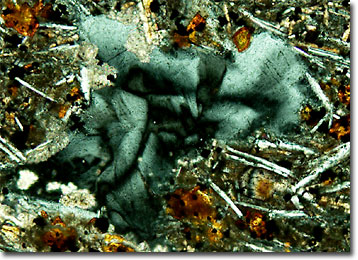Polarized Light Microscopy Digital Image Gallery
Camptonite
Lamprophyre is a term that is usually applied to seven different rocks. Although some of the rocks have certain characteristics in common, there is no single way to define the group as the whole, and over the last several decades the International Union for Geological Sciences has been attempting to improve the nomenclature utilized in regard to these, and other, igneous rocks.

Most lamprophyres are dark gray to black in color and occur as tabular bodies located in fissures of other rocks. The mafic minerals they contain are often found in the form of large crystals called phenocrysts imbedded in a fine-grained to dense groundmass, in which the felsic minerals are typically confined. Trace elements commonly found in lamprophyres suggest that the rocks originated in the Earth’s mantle with alkaline basalt rocks, but scientists do not yet agree on this matter. Lamprophyres readily erode and may decompose into a number of materials, including serpentine, limonite, and chlorite.
Lamprophyres are named based upon their mineral content. Camptonite, sannaite, and monchiquite, are types of the rock in which the predominant mafic minerals are amphibole, augite, olivine, and biotite. Camptonite is distinguished form these closely related rocks, however, by the fact that it contains a greater amount of feldspar than feldspathoid minerals and more plagioclase than orthoclase feldspar. The other commonly recognized lamprophyres included minette, kersanite, vogesite, and spessarite.
